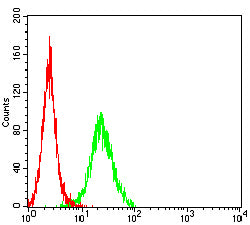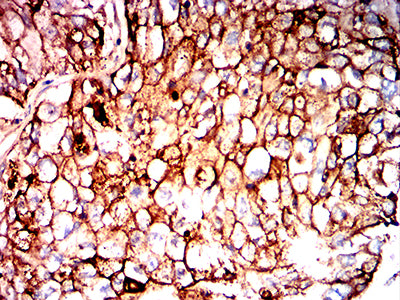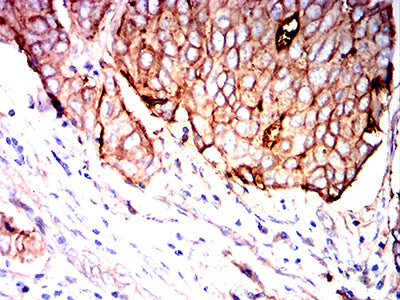



| WB | 咨询技术 | Human,Mouse,Rat |
| IF | 咨询技术 | Human,Mouse,Rat |
| IHC | 1/200 - 1/1000 | Human,Mouse,Rat |
| ICC | 技术咨询 | Human,Mouse,Rat |
| FCM | 1/200 - 1/400 | Human,Mouse,Rat |
| Elisa | 1/10000 | Human,Mouse,Rat |
| Aliases | BST2; TETHERIN |
| Entrez GeneID | 684 |
| clone | 5F3D3 |
| WB Predicted band size | 19.8kDa |
| Host/Isotype | Mouse IgG2b |
| Antibody Type | Primary antibody |
| Storage | Store at 4°C short term. Aliquot and store at -20°C long term. Avoid freeze/thaw cycles. |
| Species Reactivity | Human |
| Immunogen | Purified recombinant fragment of human CD317 (AA: extra 49-161) expressed in E. Coli. |
| Formulation | Purified antibody in PBS with 0.05% sodium azide |
+ +
以下是关于CD317抗体的3篇参考文献,按文献名称、作者及摘要内容概括列出:
---
1. **文献名称**:*Tetherin-mediated restriction of filovirus budding is antagonized by the Ebola glycoprotein*
**作者**:Kaletsky RL, et al.
**摘要**:该研究通过使用CD317(Tetherin)抗体,揭示了埃博拉病毒糖蛋白如何拮抗Tetherin的抗病毒功能,抑制病毒颗粒释放,为病毒逃逸宿主免疫机制提供了关键证据。
---
2. **文献名称**:*CD317/tetherin is overexpressed in primary mantle cell lymphoma and modulates apoptosis through the regulation of autophagy*
**作者**:Granato M, et al.
**摘要**:研究利用CD317抗体检测套细胞淋巴瘤中该蛋白的表达,发现其过表达通过调控自噬影响细胞凋亡,提示CD317可能作为淋巴瘤治疗的潜在靶点。
---
3. **文献名称**:*Antibody screening for BST-2 (CD317) expression and neutralization of HIV-1 replication*
**作者**:Perez-Caballero D, et al.
**摘要**:通过筛选靶向CD317的中和抗体,研究证实部分抗体可阻断HIV-1病毒释放,为基于Tetherin的抗体疗法开发提供了实验依据。
---
如需更多文献或具体期刊信息,可进一步补充关键词或时间范围检索。
CD317. also known as Tetherin or BST-2 (bone marrow stromal antigen 2), is a type II transmembrane protein encoded by the *BST2* gene. Discovered in 2000. it plays a critical role in innate immunity by restricting the release of enveloped viruses, including HIV-1. Ebola, and SARS-CoV-2. Its unique structure—comprising an N-terminal cytoplasmic domain, a transmembrane region, a coiled-coil extracellular domain, and a C-terminal glycosylphosphatidylinositol (GPI) anchor—enables it to "tether" budding virions to the host cell membrane, blocking viral dissemination.
CD317 antibodies are essential tools for studying its expression, function, and interactions. These antibodies are widely used in research to detect CD317 in various cell types, including immune cells, epithelial cells, and cancer cells. They help elucidate its role in antiviral defense, immune regulation, and cancer progression. CD317 is upregulated by type I interferons, linking it to inflammatory responses and autoimmune diseases. Dysregulation of CD317 has been observed in cancers, where it may act as either a tumor suppressor or promoter depending on context.
Therapeutic applications of CD317 antibodies are emerging, particularly in targeting viral infections or modulating immune checkpoints. Some studies explore bispecific antibodies or antibody-drug conjugates leveraging CD317's surface expression on malignant cells. However, its dual role in immunity and cancer necessitates careful evaluation in clinical settings. Overall, CD317 antibodies remain pivotal in advancing both basic virology and translational oncology research.
×